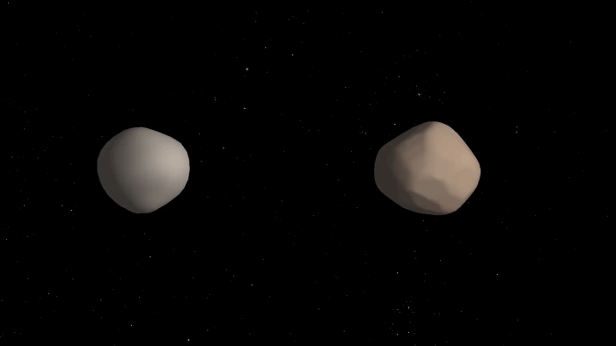Radio observations of near-Earth object reveal a rare binary asteroid
A near-Earth asteroid discovered last year turns out to be two objects of equal size orbiting each other

Artist’s concept of what binary asteroid 2017 YE5 might look like. The two objects showed striking differences in radar reflectivity, which could indicate that they have different surface properties. Image credit: NASA/JPL-Caltech
New observations by three of the world’s largest radio telescopes have revealed that an asteroid discovered last year is actually two objects, each about 900 metres (3,000 feet) in size, orbiting each other.
Near-Earth asteroid 2017 YE5 was discovered with observations provided by the Morocco Oukaimeden Sky Survey on 21 December 2017, but no details about the asteroid’s physical properties were known until the end of June. This is only the fourth “equal mass” binary near-Earth asteroid ever detected, consisting of two objects nearly identical in size, orbiting each other. The new observations provide the most detailed images ever obtained of this type of binary asteroid.
On 21 June 2018, the asteroid 2017 YE5 made its closest approach to Earth for at least the next 170 years, coming to within 6 million kilometres (3.7 million miles) of Earth, or about 16 times the distance between Earth and the Moon. On 21 and 22 June, observations by NASA’s Goldstone Solar System Radar (GSSR) in California, United States, showed the first signs that 2017 YE5 could be a binary system. The observations revealed two distinct lobes, but the asteroid’s orientation was such that scientists could not see if the two bodies were separate or joined. Eventually, the two objects rotated to expose a distinct gap between them.
Scientists at the Arecibo Observatory in Puerto Rico had already planned to observe 2017 YE5, and they were alerted by their colleagues at Goldstone of the asteroid’s unique properties. On 24 June, the scientists teamed up with researchers at the Green Bank Observatory (GBO) in West Virginia, United States, and used the two observatories together in a bi-static radar configuration (in which Arecibo transmits the radar signal and Green Bank receives the return signal). Together, they were able to confirm that 2017 YE5 consists of two separated objects. By 26 June, both Goldstone and Arecibo had independently confirmed the asteroid’s binary nature.
The new observations obtained between 21 and 26 June 2018 indicate that the two objects revolve around each other once every 20 to 24 hours. This was confirmed with visible-light observations of brightness variations by Brian Warner at the Center for Solar System Studies in Rancho Cucamonga, California.
Radar imaging shows that the two objects are larger than their combined optical brightness originally suggested, indicating that the two rocks do not reflect as much sunlight as a typical rocky asteroid. 2017 YE5 is likely as dark as charcoal. The Goldstone images taken on 21 June also show a striking difference in the radar reflectivity of the two objects, a phenomenon not seen previously among more than 50 other binary asteroid systems studied by radar since 2000. (However, the majority of those binary asteroids consist of one large object and a much smaller satellite.) The reflectivity differences also appear in the Arecibo images and hint that the two objects may have different densities, compositions near their surfaces, or different surface roughnesses.
Scientists estimate that among near-Earth asteroids larger than 200 metres (650 feet) in size, about 15 percent are binaries with one larger object and a much smaller satellite. Equal-mass binaries like 2017 YE5 are much rarer. Contact binaries, in which two similarly sized objects are in contact, are thought to make up another 15 percent of near-Earth asteroids larger than 200 metres (650 feet) in size.
The discovery of the binary nature of 2017 YE5 provides scientists with an important opportunity to improve understanding of different types of binaries and to study the formation mechanisms between binaries and contact binaries, which may be related. Analysis of the combined radar and optical observations may allow scientists to estimate the densities of the 2017 YE5 objects, which will improve understanding of their composition and internal structure, and of how they formed.
Keep up to date with the latest reviews in All About Space – available every month for just £4.99. Alternatively you can subscribe here for a fraction of the price!




